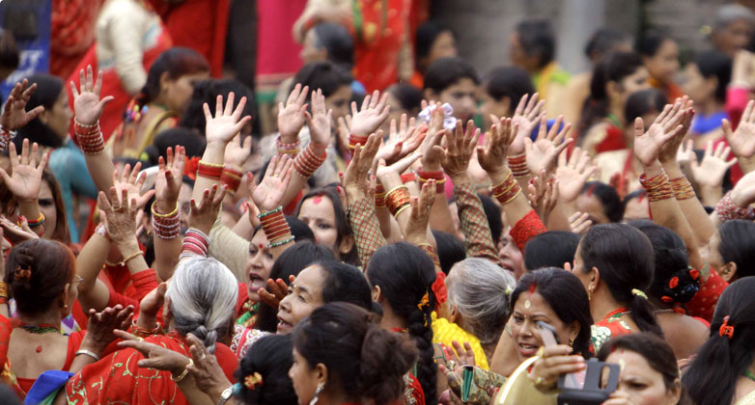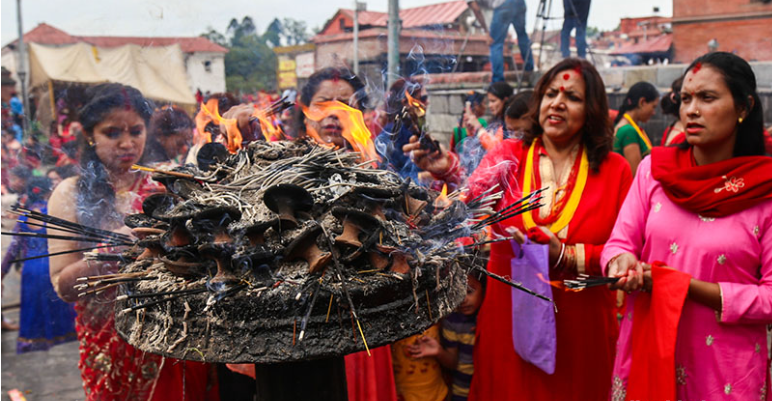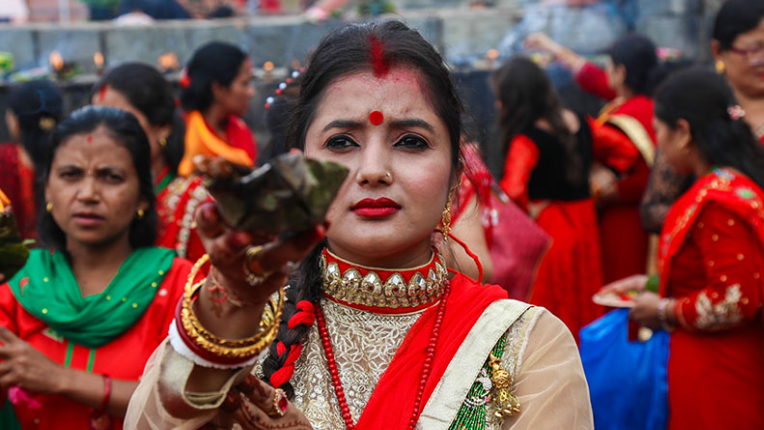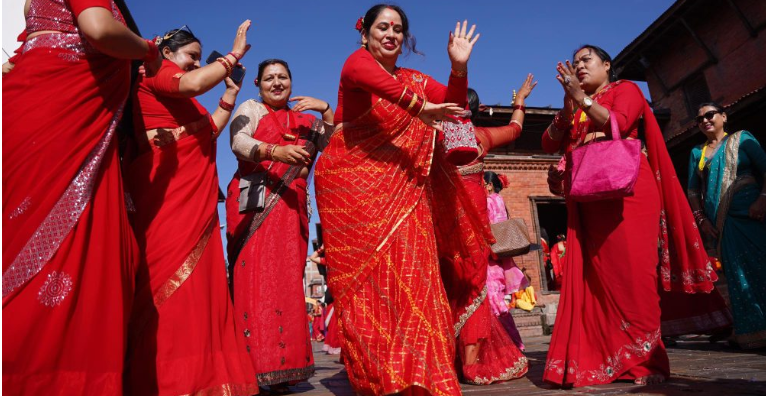As Teej festival, we understand it as an opportunity to meet girlfriends, have fun, and have fun. On this occasion, girls come to Maita. They consume dairy products. They fast. They dress up in red, green, and yellow colors. They wear bracelets and bangles. They dance and sing. He pours out his heart through the song. Now the form of Teej is also changing.
There is a growing tendency to have a harmonious relationship between girlfriends, to go to the mother’s house, instead of eating milk-based dishes, instead of eating milk-based dishes, they organize feasts in party palaces, unannounced competitions in jewelry and dress, and eating meat-fish and alcoholic Tamasi dishes. What exactly is Teej? Why is it celebrated? How did you start celebrating? What is the meaning and reality associated with it?
Why is Teej celebrated?

Haritalika Teej, the great festival of Nepalese Hindu women, has spread to every city and village of Nepal. During this festival, women fast for their health and long life of their husbands. However, with the passage of time, there has been a lot of change in our customs and culture, which is easily visible in our festivals.
Nowadays, Teej is getting more and more popular and it seems that the western style has started mixing in the festivities of Teej. As a result, the Teej has started to become a little too hectic and its originality has also started to be lost, and complaints have started to increase.
It is not possible to determine the exact date that Teej started from this time, but it can be understood that this Indian year, especially in North India and Nepal, has been going on since mythological times.
Especially, Teej is a festival celebrated more in Nepal than in India. Since the original nature of this festival has developed in Nepali society, it can be said that Teej is a purely Nepali festival and it is celebrated only by the women of Nepal. This festival, which expresses the social, religious, cultural identity of Nepali people, carries the history of Nepali women, which is manifested in various forms through this festival.
According to the religious tradition, Parvati, the daughter of the Himalayas, fasted to get Mahadev Swami and after completing her fast, she got a Mahadev husband. Hindu women have been celebrating this day as Haritalika Teej. It is said in some scriptures that even though Parvati did severe penance for 107 births to get Mahadev as her husband, her penance was completed only in the 180th birth. Following this belief, there is a Nepali custom of fasting on Teej for married women to wish their husbands a long life and unmarried women to find a suitable groom.
the religious significance of teej

Teej is an important festival of Hindus. This festival falls on the day of Bhadrashukla Paksha Tritiya. If Hasta Nakshatra and Monday fall on Bhadrashukla Tritiya, the importance of Teej increases. Since it was born from these three things, it seems that the word Teej is used from the Sanskrit word Trij.
When considering the religious and historical aspects of Teej, one has to reach the Shivagauri Dialogue. In response to Parvati’s inquiry about fasting, which gives more results with little effort, Shivaji told Haritalika’s fasting law. In which it is mentioned that fasting and worshiping at the time when all the three things mentioned above will get rid of all kinds of sins. Fasting at such a time is considered the best fast category. Such a coincidence is possible only occasionally.
It is called Haritalika because Parvati’s companions took her to the forest and hid her in the forest, rebelling against Parvati’s wish and austerity to marry Vishnu in the Himalayas. Ali in Sanskrit means friend and the name Haritalika came from the fact that Alivirhrita was kidnapped by her friends.Since the history of Teej is connected with Parvati and Shiva, it is understood that this festival has existed since time immemorial.
In particular, it can be understood that this festival tries to take the existence of women to its peak by nourishing the religious and cultural aspects through fast fasting and worship-worship.
In this festival, which is celebrated every year on Bhat Shukla Tritiya day, the previous night i.e. on the day of second day is eaten. Fasting is observed on the day of Teej. On the fourth day, the fasting women take a bath and eat food, while on the third day of Teej, i.e. Rishi Panchami, the fasting women brush their teeth with 365 dativans and apply mud to bathe.
Upmarg Lapan removes skin allergies. On the day of Panchami, along with Arundhati, Kashyapa, Atri, Bharadwaja, Vishwamitra, Gautama, Jamadagni and Vashishtha Rishi are worshiped, and only unploughed grain rice and vegetables such as crabs grown in a row or single grain are eaten. It is believed that eating food cooked by the husband on this day will increase mutual intimacy and harmony.
The ornaments and clothes used in Teej also have their own importance. Teej with religious rituals is universal. The red saree worn by women on the day of Teej is considered a symbol of happiness, prosperity and courage. There is a religious belief that red color provides a kind of power to women. Grandson brings peace and happiness while red tick is a symbol of good luck. The religious belief that if one’s heart is pure, one’s desires will be fulfilled is inherent in Teej fasting.
It is a religious belief that women should fast without water or food during Teej. In a way, it looks like it is trying to make women blind devotees of men. It is believed that religious rituals performed by women during Teej fast, which is meant to be a devotee of men, will bring longevity, good health, and progress to the husband.Social significance
Nepal is an agricultural country. Teej is a festival celebrated during some free time after planting crops. This festival of increasing mutual love creates an environment where women express their pain. After planting the crops, it is customary for the father or brother to visit the daughter-in-law during some free time and return with the wife as much as possible, which strengthens the relationship between the mother and the daughter. By bringing together sisters who are far away after getting married, this festival gives them an opportunity to lighten their hearts and talk about happiness and sorrow.
For the last few years, there has been a change in the form of eating on the day before fasting. Social customs have changed in some middle-class homes.
The custom of sending dowry to the daughter’s house in the first year of marriage has started to increase. This has forced the in-laws to bear more financial burden for their daughter. In the process of sending the price, the custom of sending jewelry, clothes, shoes, cosmetics, etc. along with 11 types of food to the daughter’s house has been started.
In addition to this, it seems that the sanctity and core meaning of this festival has been attacked by the rampage that has been going on for months in the name of eating and feeding. While the wealthy class enjoys such a custom, the problem can be complicated when the eater class also tries to make appearances. It cannot be ignored that this may create a new problem of class discrimination in the society.
As a side effect of this practice, unnecessary comments are made about who will bring how much in a house with many daughters-in-law. The unfair and unnecessary competition that insults and insults the daughter-in-law who brings less and gives more respect to the daughter-in-law who brings more can affect our social harmony and harmony.
Such social behavior has overshadowed Teej’s real purpose. The social importance of Teej is very great if such wrong tendencies are to be removed. Cultural significance
No matter how modern a person is, he cannot leave the traditions and culture he was born with. The festival of Teej, which is celebrated by the Hindu community in Nepal, is now being celebrated by other castes as well. As Teej is also considered as a women’s festival, girls also enjoy it. Retiring from work for some time, gathering of family, friends, walking, dancing becomes another feature of this festival.
Songs and music have special importance in Teej. Women used to gather in groups and sing songs in the absence of electronic devices and instruments, but now modern-style songs and dances are heard on radio and television. The songs of Teej used to include differences between children, pain, mother-in-law’s anger, sorrow, jealousy, etc. But now the themes of Teej songs have also changed. As a cultural tradition, women sing songs and gather in nearby temples or groups and hum the tunes of Teej in different languages.
Most of the women who are stuck in the busyness of cooking and housekeeping, open their hearts on Teej and pour out their sorrows. At present, there is no such situation in the homes of all Nepali women. In Toltol, a group is formed and a program of dancing and eating is conducted a month before. Some organizations also organize Teej competitions. It has not only killed the special meaning and importance of Teej, it has also made the Teej full of traditions and culture vulgar and violent. However, it is a good thing to introduce Teej culture to women of other castes or communities.
We should refine Teej in such a way that traditional beliefs and methods do not die. Modern women who have grown up in an educated and civilized society should break the superstitions and take initiative to make Teej festive and ritualistic. Teej should not be made vulgar and rude in the name of modernization.
Women who consider themselves to be modern and urban gather in hotels, hold parties and indulge in alcohol. This is the most smelly side that has entered in the name of Teej. The custom of wearing jewelry not only for honor and civilization and to look beautiful but also for the appearance and competition of others has also entered. It also increases the financial burden. Such behavior also overshadows the original culture. It is necessary to remove the distortions to revive the cultural importance of this festival.
Traditional Significance of teej

The tradition of Teej is very old and is believed to have started with Parvati, daughter of the Himalayas. It is a traditional belief that fasting on the occasion of Haritalika Teej with holy vows will help unmarried people get a good husband and married people will get long life and good health for their husbands. Similarly, the traditional significance of Panchami, which is celebrated after the fast of Haritalika Teej, is different.
Whether married or unmarried, all women celebrate this day. It is said that 365 Dativan stalks bitten on Panchami will get rid of all the physical, verbal, and mental mistakes done unknowingly throughout the year.
There is a tradition that this day is directly connected with women’s menstruation. Young women participate in Panchami Puja only after their first menstruation, while married adults and women believe that even if they accidentally touch things or deities that should not be touched during menstruation, after biting Dativan, all sins will be washed away. The traditional importance of the Teej festival has come to be associated with relationships.
Teej is a festival to improve relationships, make them stronger, and change the misunderstandings in the relationship into love. Even now, its faith and importance are the same. We have traditional rites such as singing old songs and songs along with the taste of Adilo chamre, unadiko latte, bitter gourd pickle covered with sesame seeds, observing fast without drinking water, eating karkalo after Panchami puja. As much as one learns culture through association with the first generation, it is not gained by watching others do it.
conclusion
Earlier, Nepali women were not independent and self-sufficient, even if it was just one day, the family members would gather for a long time to eat sweets, while the girls would wait for months in advance.
. They used to enjoy that day as a day to indulge themselves and enjoy themselves freely. Nepali women who come from the tradition of mother-in-law get a chance to enjoy good food, eat sweet food, be free and open their hearts and dance, so this festival is a soulful festival for Nepali women and they used to wait anxiously for it.
However, the Teej seen by today’s generation is very different compared to earlier. Now it seems that other aspects of Teej are more emphasized than the religious aspect. Today, a completely different culture is being developed regarding the festival of Teej.
The duration of the Teej program, which is organized not only in family gatherings but also socially, politically and institutionally, is getting longer every year and it is also becoming unnecessarily expensive. Seeing that the main aspect of Teej is becoming secondary and other aspects are getting a prominent place, it seems natural to be worried that this festival itself will be distorted.

